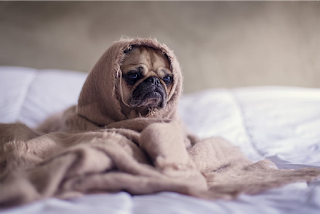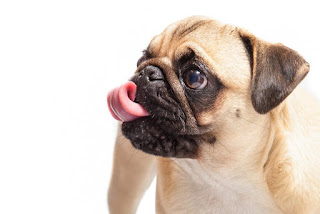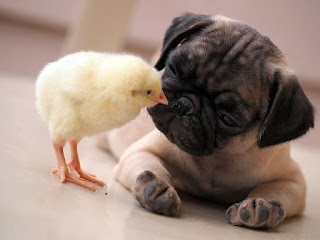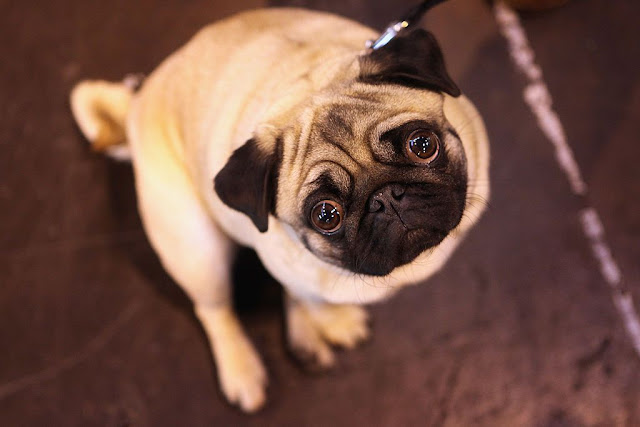The Pug, also called the Chinese Pug, Dutch Mastiff and
Dutch Bulldog, is an extremely old dog breed that was developed in China at
least 2400 years ago. The importance of the breed's name is indistinct, in
spite of the fact that it is conceivably slang for "monkey" or is
gotten from the Latin "pugnus," signifying "clench hand."
Easily conspicuous because of their stocky bodies and noticeable eyes, these
prominent friend creatures were regularly supported pets of priests and regal
families in Europe and China. The little size and generally low exercise
prerequisites of the Pug make it appropriate for living in lofts. Vivacious,
headstrong and tender, this breed has a strong, minimal form that empowers it
to play securely with youngsters. Pugs are energetic, ready creatures that
carry on affectionately toward individuals all things considered and coexist
well with different dogs. The American Kennel Club formally perceived the Pug
in 1885, and the breed is a piece of the Toy Group.
History
The emperors of ancient China had an inclination for level
confronted toy dogs—the Pekingese, Shih Tzu, and Pug were altogether created as
refined pets of the sovereign, his family, and individuals from the majestic
court. In the same way as other breeds supported by a long shot Eastern
overlords of the old world, Pugs were a firmly held fortune that pariahs could
get just as a blessing.
The Pug's profession as native of the world started at some
point in the 1500s, when Dutch brokers came back to Europe with examples of the
breed. Legend holds that the Pug turned into the mascot of Holland's imperial
House of Orange when a Pug spare the life of the Prince of Orange by yapping to
caution the ruler of an assault on his camp by Spanish troops. Whenever William
and Mary of Orange touched base in England to expect the government, their Pugs
went with them and started a fever for the breed among the British.
The overall interest with Pugs can be measured by what
number of names the breed has had in different periods and spots: Lo-Sze
(China), Mopsi (Finland), Doguillo (Spain) are only a couple. Among the Dutch,
still nearly connected with Pugs, they are known as Mophonds.
Speculations proliferate with regards to the birthplace of
the name Pug. One proposes that Pug depends on the Latin word
"pugnus," signifying "clench hand"— the thought being that
the dog's face looks like a gripped clench hand.
Size and Weight
Because of their small size, Pugs are in the toy class of
canines. Male Pugs are normally 12 to 14 inches tall, and they measure 13 to 20
pounds. Female dogs are somewhat littler at around 10 to12 inches tall, and
they regularly weigh around 13 to 18 pounds. Pugs love nourishment and treats,
and appear to have a characteristic proclivity for asking. These
characteristics can make propensities towards stoutness if not painstakingly
observed.
Personality
Pugs are not the vivacious socialites that a portion of the
toy breeds are. They are more genuine, with a dry comical inclination. The
breed proverb is "multum in parvo," which means a great deal in a
bit, with a lot of dog in a little bundle. Pugs can be tenacious however
regularly need to please.
These are genuinely laid-back dogs, not generally given to
broad woofing, burrowing or biting. Pugs have a tendency to coexist well with
different dogs and are sufficiently tough to coexist with youngsters. They
appreciate organization and can be very loving. Consistent with their
gathering, they are great buddy dogs.
Grooming
Grooming a Pug's coat is simple. Brush his smooth twofold
coat week after week with an elastic curry brush to evacuate dead hair. What's
more, you will expel loads of it, since Pugs shed. A considerable measure. They
shed year-round, so it's something you should hope to live with.
The Pug's facial wrinkles, particularly the profound nose
roll, must be cleaned. Every Pug is an individual, so you may need to clean
them day by day or just week by week. Wipe out the muck with a hosed corrective
wipe or child wipe, at that point altogether dry the wrinkles so they don't
mold or end up tainted, a condition referred to Pug individuals as
"overwhelm confront."
Bathe the Pug as required. With the delicate dog shampoos
accessible now, you can bathe a Pug week by week in the event that you need
without hurting his jacket.
The rest is essential care. Trim the nails each week or two,
and brush his teeth frequently — with a vet-endorsed pet toothpaste — for good
general wellbeing and new breath.
Coat and Color
Their conservative casing sports a smooth, delicate coat
that arrives in a grouping of hues. A portion of the more typical hues seen on
Pugs incorporate black and stoop, which is a light tan. They are additionally
known to arrive in a shading called apricot that is redder than the grovel
hues. The rarest of the accessible Pug hues is silver, and it is exceptionally
looked for after. All hues have the trademark black face veil and a thin black
line which keeps running along the spine. This is known as a "follow."
The layer of the Pug breed is short and regularly twofold
layered, with a smooth, smooth layer of longer hair to finish everything and a
shorter, fluffier layer underneath. This kind of coat gives the Pug a notoriety
for being a productive shedder. Frequently, unwavering Pug proprietors pick
their furniture hues as per the shade of their Pug to diminish the
perceivability of the hair.
Temperament
Happy-go-lucky and full of energy, the Pug is a vivacious,
carefree breed, with heaps of identity stuffed into a little bundle. Pugs are
regularly called "shadows," as they want to stick themselves to their
proprietors' sides and remain nearby to the activity. While they do have an
adamant streak, they are for the most part not forceful, and regardless of their
little casings, they are hefty little dogs, making them incredible pets for
families with kids. When they are not resting (which happens often), Pugs are
quite often beguiling, vivified and prepared to play (or eat). Pugs do best in
homes where they get a lot of consideration and are dealt with like individuals
from the family, and thusly, they offer stacks of commitment and love.
Living With
Pugs are to a great degree simple to keep and have a genuine
propensity to end up fat except if their eating regimen and exercise are
observed painstakingly. With the short gag, they don't do well in sweltering,
damp climate and must be watched precisely for heatstroke. Pugs complete tend
to wheeze, again a consequence of the short gag. The noticeable eyes are
effortlessly harmed and mind must be taken to keep them soggy. Pugs are
genuinely hearty and regularly live to 14 or 15 years old.
Pugs do best with some every day exercise to help with their
weight issues. In spite of their chivalrous alert years prior, they are not
typically awesome watchdogs, favoring rather to welcome newcomers with a
swaying tail. Pugs ought to be associated to keep that active disposition, and
they do well with different pets.
Prepping is imperative, both for the shedding from the thick
coat and to keep facial wrinkles clean. A speedy day by day prepping, even a
swipe with a dog glove, for the most part gets the job done for the coat and a
delicate wiping with a wet fabric for the face.
Here Some Awesome Picture Of Pug
Thanks and Please Share This Beautiful Dog Breed With Your FriendSs..






















No comments:
Post a Comment